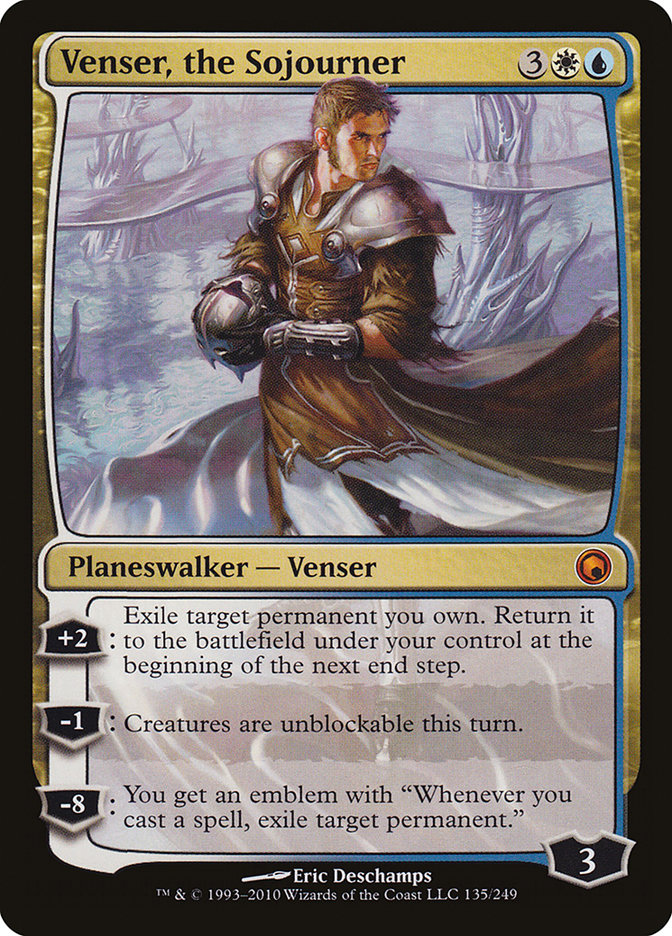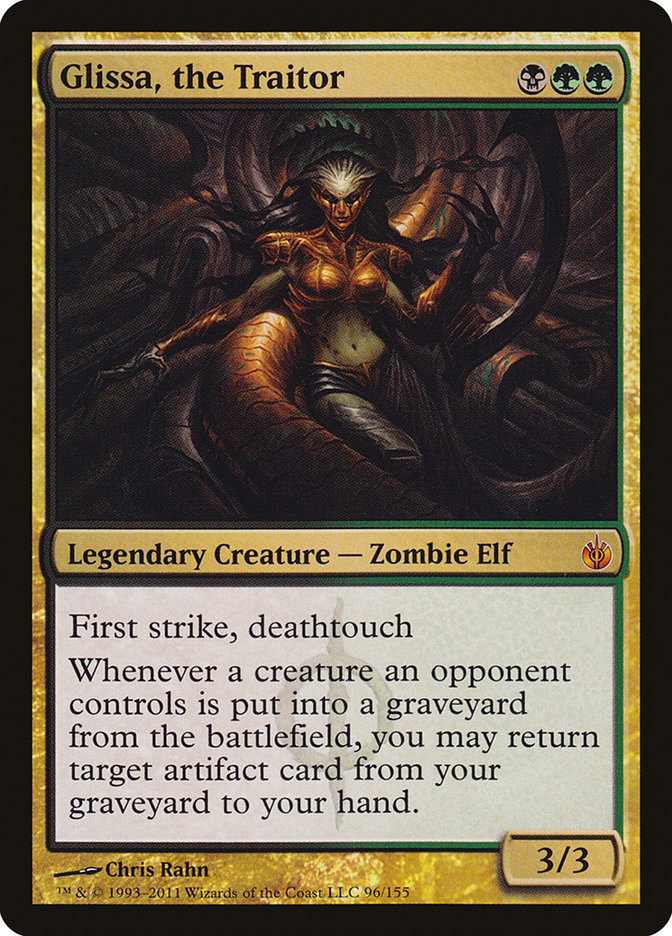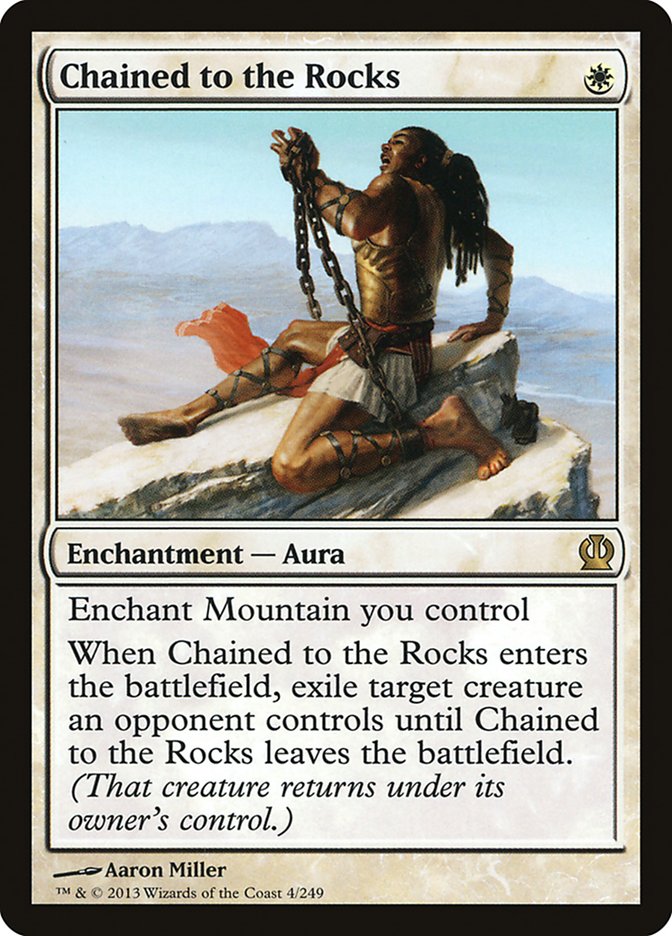Storytelling focuses largely on those who go on to do great or infamous deeds. It’s a concept related to—though not exactly the same as—survivorship bias; there is a more interesting story to be told about British Major John Andre despite his death at the age of 30 than about an individual who was born in similar circumstances but died of the bloody flux at six months old.
Magic’s storytelling is no different. Consider the many planeswalkers whose stories have been told. What they have in common—besides the planeswalking spark—is that they lived long enough to be interesting. Oh, sure, they get into trouble, and that’s three-fourths of the fun. Yet how many planeswalkers who’ve appeared on planeswalker cards are canonically dead?
Just this guy. Well, almost all of him.
For all the various planeswalkers’ differences, they share a remarkable run of luck in their early (and middle, and late) planeswalking. The things that could go wrong are innumerable. If you want to survive your first planeswalk, here are a few you’ll need to break your way.
Step 1: Your planeswalking spark actually has to ignite.
Not every sapient creature born with a spark ever leaves the home plane. Glissa Sunseeker had a planeswalker spark, which was the whole reason Memnarch tried to hunt her down in the first place. But she lost her spark to Slobad, Goblin Tinkerer and the goblin used it up to bring the recently dead of pre-Phyrexianized Mirrodin back to life. What good did Glissa’s spark do her in the end? It didn’t save her from a nice helping of compleation and the destruction of all she loved.
Ordinarily a first planeswalk is a reaction to extreme stress or danger, like Tibalt, the Fiend-Blooded getting the door to his torture lab kicked down. One can only imagine that these first planeswalks sometimes happen a split-second too late, leaving the spark-owners to bleed out in the Blind Eternities separating worlds or at their unknown destinations.
So if your planeswalking spark ignites in time to be useful . . .
Step 2: You have to land somewhere . . .
The act of planeswalking is not an entirely risk-free activity (word of Doug Beyer). Getting lost in the Blind Eternities, where the very structure of the Multiverse wants to tear you apart? Not my idea of a good time . . . and the trip with the greatest risk is the one where the planeswalker has no idea where the destination is because the mind can’t begin to conceive of other planes.
So you successfully land on another plane . . .
Step 3: . . . that won’t instantly kill you.
Suppose the Solar System were a plane. So far in our understanding the Pale Blue Dot called Earth is the only locale in the Solar System that supports sapient life. A planeswalker landing on Mercury or the Moon or Miranda—barring a complete suite of spells required to sustain that planeswalker’s existence—is seriously out of luck.
On Earth there would be good and bad places for a human planeswalker to land. The South Pole? Not good. The bottom of the Marianas Trench? The top of Mount Everest? Dead and dead. Even a more generally hospitable place ranges from “safe” to “trouble.” Take my current metropolitan area of residence, Dallas/Fort Worth, and one of its star attractions, the Dallas Zoo; there’s a heck of a difference between inside the cheetah habitat and outside.
Aww, look at the cute widdle predators!
Suppose you end up in the middle of the Indian Ocean but instead touch down on solid ground near sapient beings. Congratulations! You have a long way to go.
Step 4: Without anything but the barest knowledge of local cultural norms, you have to make first contact.
Maybe it’s because I’m a total word nerd, but I’ve long had a hard time with fiction that assumes people from different worlds have no trouble understanding one another. In the Flight of the White CatMagic webcomics . . . Actually, this is a huge spoiler, so read the webcomics before you go on. I’ll put up a picture of an Alpha Black Lotus in mint condition, and you can scroll below it when you’re set.
It can be yours for the low, low price of $9,999.99. You know you want it.
All right, spoiler time!
So Ajani planeswalks from his home plane of Naya to Jund, almost gets eaten by a dragon (that whole hostile environment thing), gets saved by Sarkhan Vol, and then except for a moment where Ajani wonders what a “planeswalker” is, they have a totally normal and clear conversation.
Did they have a spark-to-spark talk? Did Ajani’s enhancing-others magic let them chat? Someone probably has a Magic-lore answer (paging Barinellos!), but it just doesn’t make sense to me.
Even on this Earth I would have a rough time if randomly dropped off in many places. My languages are English and the shriveled remnants of schoolboy Latin, neither of which would be particularly useful in a remote Peruvian village. That leaves interpreting tone of voice and gestures, both of which have their own perils.
So you get to a hospitable destination, and first contact goes well. It’s not over yet . . .
Step 5: You can’t afford to get sick.
Remember, planeswalking typically is associated with severe mental trauma and near-death experiences. After a first planeswalk, the newly made planeswalker is going to have to go beyond that first contact and at least for a short amount of time interact with a larger group of locals. In “The Lost Confession,” an Uncharted Realms story presented as a letter-prayer written by Elspeth Tirel, Elspeth describes how she planeswalked away from the corruption of New Phyrexia and landed not only on Theros, a plane she knew, but right next to a cave full of snake-obsessed healers—a “stroke of good luck” indeed.
What is there to guarantee that a planeswalker who traveled from some other plane to Earth wouldn’t die from influenza or some other disease? It’s been less than a century since an influenza pandemic killed tens of millions and fictionally triggered the turning of Twilight‘s Edward Cullen into a vampire. [More relevantly to my fiction tastes, it also affected the main characters in Katherine Anne Porter’s Pale Horse, Pale Rider.]
There’s also the converse of the planeswalker getting infected on a new plane: bringing previously unknown diseases with him, her, or Ashiok. In Magic lore, Karn and the corrupting Phyrexian oil is the obvious comparison, while in Earth’s history the introduction of smallpox to the Americas led to a series of disastrous epidemics. If the locals suspect you’re the source of some new deadly disease, they might—might—beg you to purge it. More likely they just kill you and destroy your corpse.
Speaking of smallpox, there’s another lesson to be learned from the various bad things done by European explorers . . .
Step 6: You can’t overplay your hand.
Even those who started out in a position of strength many times were killed when they committed hostile acts or outstayed their welcomes; Ferdinand Magellan and James Cook are perhaps the most famous names on that particular list. They also had sailors with them (and in Cook’s case Marines), While a planeswalker travels alone, making diplomacy (or at least the magical strength and physical integrity required for a quick exit) all the more important. That’s assuming the locals will permit said diplomacy in the first place. A woman planeswalker who landed in Saudi Arabia would get in major trouble just for being out in public alone. A human planeswalker from Theros who landed in Phoenix, Arizona with no English and no paperwork probably would be arrested as an illegal immigrant.
Even if the locals are friendly and stay friendly, the out-of-towners might not be . . .
Step 7: When you encounter your first “other” planeswalker, hope for the best.
The default psychological setting for planeswalkers appears to be “sociopath.” Sure, there are exceptions; Gideon Jura might find himself on the wrong side sometimes, but he approaches situations from his understanding of justice and—at least as far as I read his character—wouldn’t let loyalty, also one of his major virtues, overwhelm that sense of justice.
He and his ilk are in the distinct minority though. Before the events of Return to Ravnica (and for a great deal during them), Jace Beleren is pretty darn selfish, and he’s the unofficial mascot of Magic. As Doug Beyer described, planeswalking once mastered is the power to walk away from almost any situation. Burned every bridge in Lorwyn? Maybe you don’t want to go back there, but there’s always Ravnica or Kamigawa. Someone like Domri Rade doesn’t need impulse control as long as he has magic and the ability to skedaddle. Only Sorin Markov knows on how many planes he’s done his “bad boy vampire” shtick.
There’s definitely a sliding scale of planeswalkers who’d be good or not-so-good to encounter. Ajani Goldmane was lucky to meet Sarkhan Vol rather than Sarkhan the Mad for instance. Gideon Jura wouldn’t be so bad to meet if he views you as good; otherwise, you’re in for a literal whipping. Elspeth Tirel is in much the same boat, but I’d take the Jessica Fletcher approach with her all the same.
Protip: Less time explaining email to the walking murder attractor, more time running for your life.
Jace Beleren? I hope you like mind probes. Garruk Wildspeaker? Don’t get between him and a beastie. Chandra Nalaar? Don’t be flammable. Sorin Markov? Be more useful to him than as his next meal. Liliana? I hope you’re asexual and immortal. Nicol Bolas, Planeswalker? I suggest learning the Draconic for “I’m screwed.” That way the Elder Dragon doesn’t have to translate as he gloats over your sure-to-be-torturous demise.
Step 8: Repeat planeswalking until it’s perfect.
After this, congratulations! You’ve beaten the odds and become a certified menace to the Multiverse. Now get out there and kidnap some ordinary denizens of various planes so they can fight dirty magical duels on your behalf. You could be the star of a Magic storyline! (Or at least your local Friday Night Magic.)
I hope you’ve enjoyed this brief look at the astronomical odds planeswalkers face. Join me in two weeks when I’ll discuss Tales of Game’s Presents Chef Boyardee’s Barkley, Shut Up and Jam: Gaiden, Chapter 1 of the Hoopz Barkley SaGa; the Cahokia Mounds State Historic Site; or Magic. Probably Magic.
— JDB
@jdbeety on Twitter




